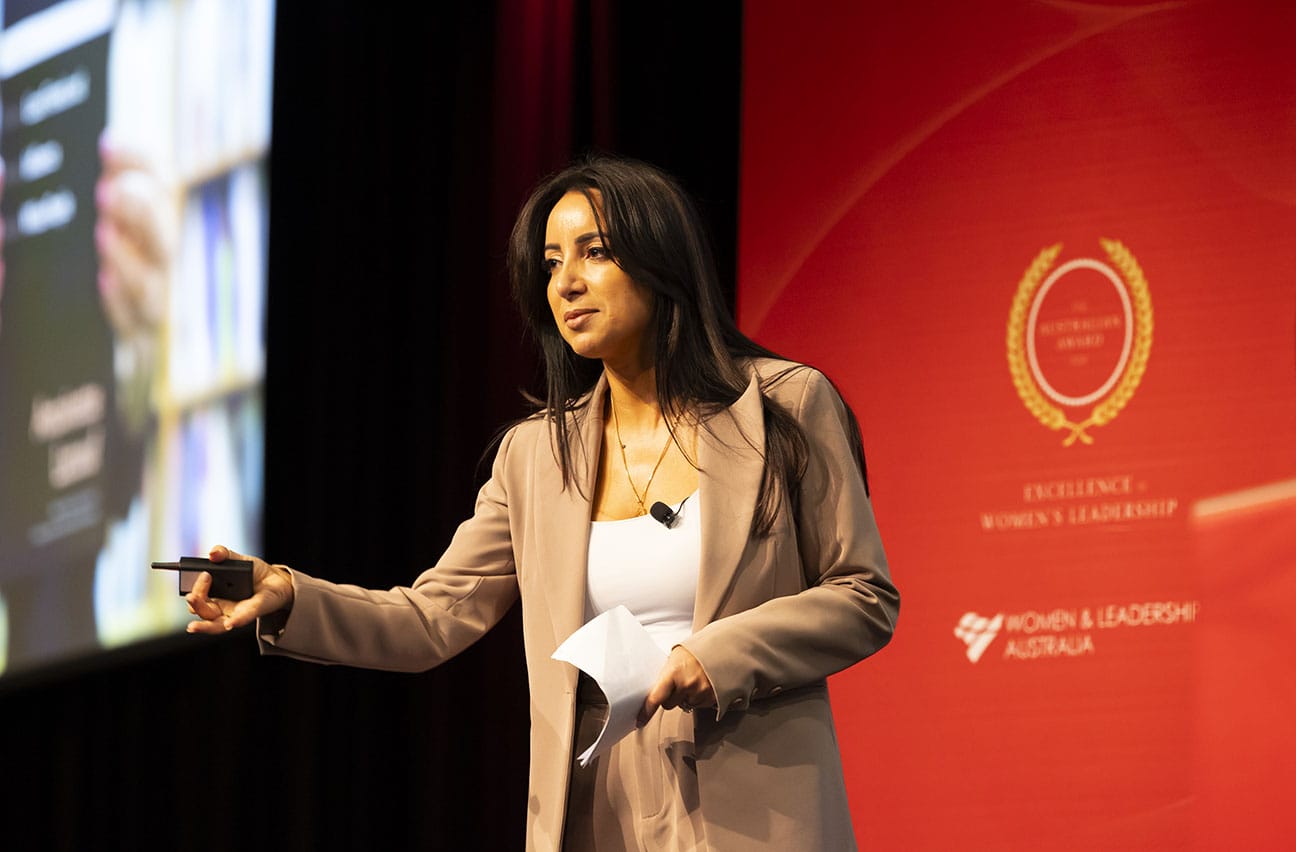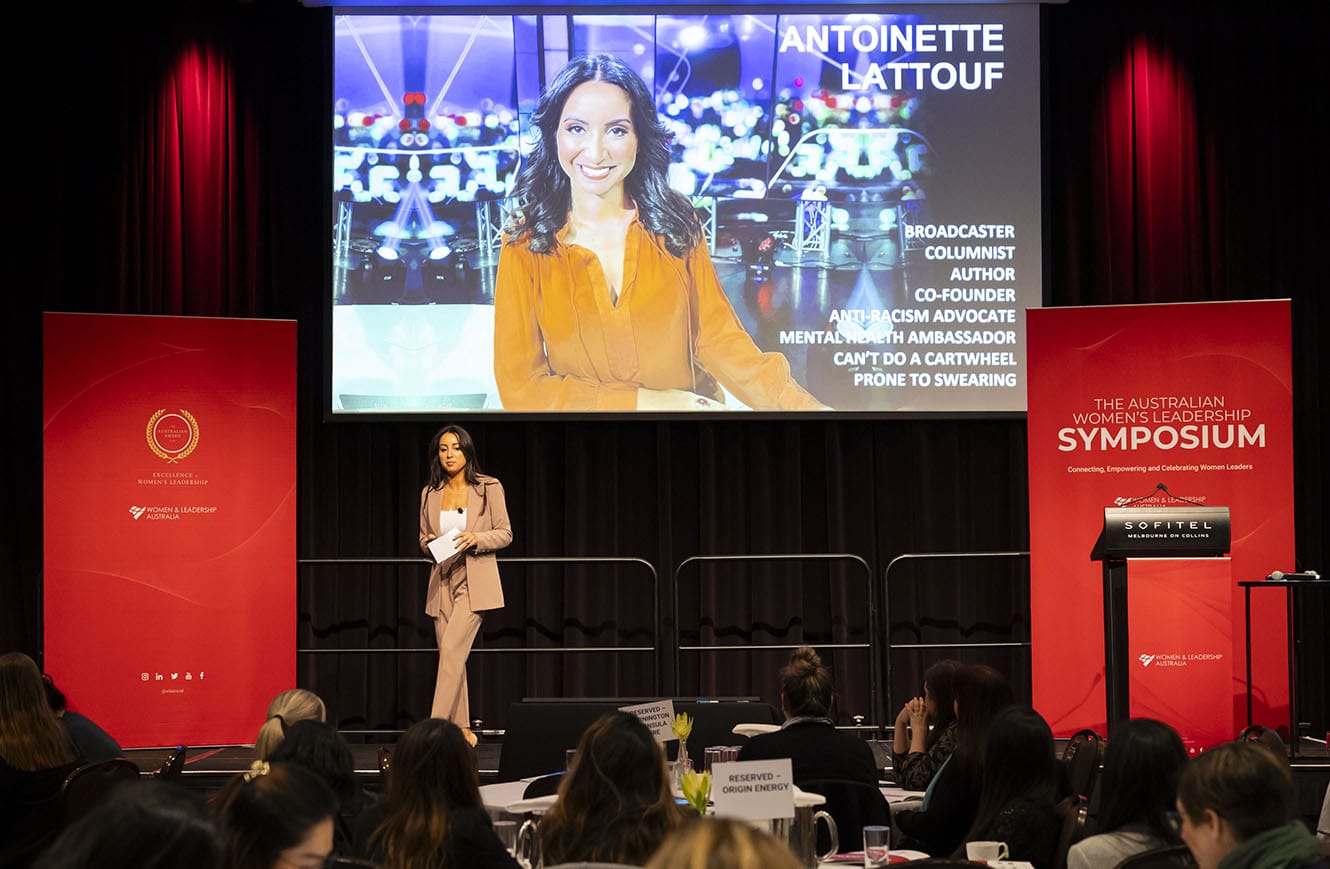After spending a decade working in mainstream media I realised not only were things not improving on the representation and inclusion fronts, but they were also in many cases getting worse. So rather than be a frustrated couch critic, I wanted to advocate for change and do the work that was needed to get those uncomfortable conversations going... to deliver change.
Antoinette Lattouf is a broadcaster, columnist, author, speaker, diversity advocate, mental health ambassador and terrible at reverse parking*. (*her words, not ours)
Antoinette was a keynote speaker at the Melbourne leg of the Australian Women’s Leadership Symposium in August. She spoke about her family, diversity, equity and inclusion in workplaces and the media, AI developments in recruitment and how in 2018 she became an “accidental leader”. For this she credits her frustration that the media at that time was making things worse for equity and racial harmony, that she could either leave the industry or do something to change it. She went on to co-found the organisation Media Diversity Australia.
We had the chance to ask Antoinette some follow up questions about her passion for storytelling, journalism and equality. Read Antoinette’s insights below.
When did your passion for telling stories develop?
It started when I was in primary school. I would ask many questions of my parents and relatives about their lives in the Middle East, what it was like being a refugee, their experiences of racism, how they adjusted to a new home with no money and no skills and no language. My fascination with the human experience was definitely obvious from a young age.
What motivated you to become a leader?
I never sought to be a leader or thought I would co-found a not-for-profit. I am a journalist and storyteller first and foremost, but it was after spending a decade working in mainstream media that I realised not only were things not improving on the representation and inclusion fronts, they were in many cases getting worse. So rather than be a frustrated couch critic, I wanted to advocate for change and do the work that was needed to get those uncomfortable conversations going and all the legwork it takes to create pathways and programs to deliver change.

How do you feel about the current state of diversity and inclusion in the media industry specifically?
There are definitely pockets of progress, but it’s ad hoc and inconsistent what the second iteration of the research ‘Who Gets To Tell Australian Stories 2.0’ showed that while places like the ABC made some on-screen representation gains when it comes to things like leadership and boards there is still a gross under-representation across all networks.
One of the commercial networks somehow became more white on screen as the country became more multicultural, and in the aftermath of Black Lives Matter, so that was incredibly disheartening. But across-the-board beyond what you see on screens, the real challenge is to get people of colour in editorial leadership roles, and on the boards of these networks, that is where the real power and change lies.
“...even if a woman is put on a board or in a leadership role if it’s in a hostile and culturally unsafe environment how is she expected to thrive.”
Why do you think that women are so underrepresented in managerial & leadership roles?
There are a range of reasons why women are underrepresented in managerial and leadership roles because there’s still plenty of research that shows that at the early stages of recruitment, simply having a females name on a CV is linked to bias, either unconscious or otherwise, where women are more likely to automatically be put in the ‘no’ CV pile.
Also, rather than hiring for the benefit of a team or workplace, too often people hire in their image so they look for somebody who will ‘fit in’ which really means be like everybody else. So, you get clones of the same men in power.
The inability to truly adapt and reflect the needs of modern families in all their forms is also why women are more likely to be punished or deemed not appropriate for a leadership role.
The other part is the inclusion part, even if a woman is put on a board or in a leadership role if it’s in a hostile and culturally unsafe environment, how is she expected to thrive?
How can organisations better support and empower women and underrepresented people?
There is so much that organisations can do to better support and empower women and other underrepresented people.
Having a diversity and inclusion plan with clear targets and goals that is communicated well to your organisation and stakeholders is one.
Taking the time to really understand your workforce is another aspect, too many organisations don’t actually have demographic data on their employees so this would capture gender race, disability, First Nation, gender and sexuality and then you’re able to actually map where these people in underrepresented groups are they most likely to be placed. Is it in lower-ranking or lower-paid roles? Are they more likely to leave the organisation sooner? Or perhaps more likely to be engaged in part-time or precarious work contracts? It’s not until you have a real understanding of the dynamics of your workforce, and a more granular look at where inequalities exist within pay structures, or with employment prospects and promotions that you really begin to unpack where the barriers are what work really needs to be done to challenge this.
Remember it’s a work in progress and organisation needs to continually reflect on why they are not meeting targets and asking what’s happening to workplace culture that’s getting in the way of inclusion. Are middle managers being trained to embrace the goal of a more diverse and inclusive workforce, if they’re not that level of hostility and microaggressions can often undo, even the best of intentions that a DE&I plan has.
During your keynote you spoke about AI tools in recruiting and HR processes, how can we ensure that AI is used in a responsible and ethical way?
There hasn’t been enough scrutiny of HR AI tools from AI ethicists, regulators, and policymakers, we definitely need more work done in this area. We also need specific training for recruiters, HR professionals, and developers – on how to use these tools to eliminate rather than amplify bias.
We need to demand AI vendors make their data transparent, they should tell us how they address bias, as well as share information about the data they feed into their software; or by running training workshops on using these tools to address bias in recruitment.
Some workplaces are even allocating an internal AI specialist who as part of the role is required to stay across rapidly changing AI.
But crucially we should only be using AI as one data point, it’s not a silver bullet Tech developers and workplaces must also shift their focus from individual instances of bias to the broader inequalities impacting recruitment processes — we can’t code away structural discrimination and bias.
How do you balance your professional life with personal commitments and maintain a healthy work-life balance?
I need lots of sleep and lots of exercise or I start feeling drained, cranky, and anxious. So, these two things are a must in my life and while to do both well, it requires what some as see as “wasting time” but you get so much back from adequate sleep and exercise. I also have two daughters and their father is wonderful and very involved in all aspects of their life. It’s this partnership that gives us both time and space to find balance.
I am also fortunate to have a big fat Lebanese family who live close by and so I very much have a village and for that I am most grateful.
Crucially, it’s a constant work in progress, the balance isn’t always right. There are times when my anxiety peaks, or I can tell from my kid’s behaviour that they need more of my attention or sometimes the laundry basket needs more attention and so we’re constantly reflecting and trying new things.

